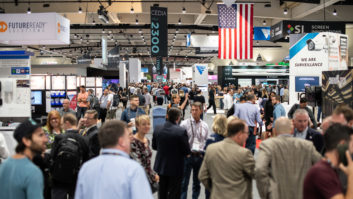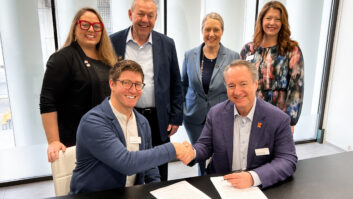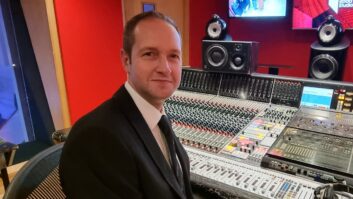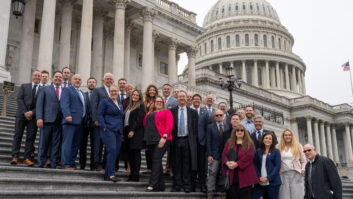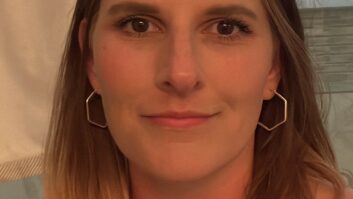At the conclusion of CEDIA EXPO 2003 last September, Home Media’s Ray Lepper took the helm of the residential systems industry’s largest trade association. As president of the Custom Installation Design and Installation Association, Lepper set initiatives to improve the educational structure of the industry and to raise the standards for membership in the Association. Last month, Lepper took time out his busy schedule to speak with Residential Systems editor, Jeremy Glowacki, about his first presidential term and his expectations for the year ahead.
Jeremy Glowacki: So it’s been almost a year since you took over as president of CEDIA. Generally how would you assess the experience thus far?
Ray Lepper: It has been, in some ways, easier than I had expected and, in some ways, more difficult. The biggest thing that I’ve benefited from in my term is the work that we set in place over the last three or four years. And that’s the development of a solid council structure and the development of our executive staff. In the old days, work got done at CEDIA through the heroic efforts of a very small number of individuals. The management structure that we’ve got in place now–both managing volunteers and executive staff–means that we can get a whole lot more people aimed at our goals and objectives. My job, then, instead of being the “chief do-er of things” is more like a president or CEO’s job, where I ask, “Do we have the right people in the right jobs, what business are we in and can we finance our business?” I’ve been able to work directly with the council chairs to make sure that they’re all aiming at the same strategy.
One of the things that I remember from previous administrations was that there was a lot of travel involved to visit your counterparts in Europe or Australia. It seems like that took presidents away from their own businesses more. Has that been true for you, too?
No, I’m at home more than I expected. Once again I think that having the executive staff there has been a big help. A big change that occurred at the end of last year was the way that we would manage CEDIA globally. We went down a track of trying to be, in a way, all things to all people to provide a tremendous level of service out of the U.S. in support of CEDIA organizations in other parts of the world. What we realized along the way was that we actually couldn’t do that good of a job because ultimately it comes down to a lot of volunteers rallying around the issues and the opportunities. U.S. volunteers are never going to be a good replacement for local volunteers in their own countries.
So the whole restructuring of our global relationships with our licensees in the U.K. and Australia really said “Look, we’re not going to do that work for you. We’ll show you how we do it. We’ll facilitate some of that work through our systems procedures, intellectual property, and education content. You can have whatever we have, but we aren’t going to do the work for you.” We established a core set of parameters where we would operate with the same branding and brand positioning and intellectual property, but beyond that, the implementation of it would be up to them. At first they thought we were cutting them all loose, but I think it’s worked well. They’re rising to the occasion and they call us when they need stuff.
Last fall you outlined some of your goals, which included the creation of CEDIA University (or an enhanced educational curriculum for the industry) and your concept for raising standards for CEDIA membership. Give us an update on those two big initiatives.
They’re both progressing well. Let me tackle the membership one first. The concept of really making the CEDIA Brand mean something meant that we’ve got to raise the requirements for membership. We’ve got to make it a little more difficult to be a member so we separate out the folks who are really committed to being the best in the business from the folks who just wanted a discount at a trade show. We now have achieved, through membership chair Ken Smith, a change in bylaws, which provides for three tiers of membership. We have agreed to implement the first tier, which is actually the easiest. It’s for “provisional” members, which provides a point of entry for a new business into CEDIA and access to the business building tools that we develop. Provisional members will pay a little less for membership, they get access to our business-building tools, but they don’t get to fly the CEDIA flag. They don’t get to put the CEDIA logo on their business cards and their vans. We expect these folks to rise to Full Member status fairly quickly, and we want them to do that.
Simultaneously we’ve, in essence, clarified and restated the membership requirements for “full members.” They are exactly as they have been in previous years, but we’re saying, “Remember, everybody, these are the requirements,” and we’re going to be much more rigorous in enforcing them. We work on the honor system, and that’s a good thing. But, by the same token, if you’re not licensed in your state and one of your competitors finds out, he’s going to pop you; that’s just competition. People don’t appreciate having to go get a license and maintain it; meanwhile a competitor gets to ride for free. What you’ll see now over the next two to four years is a rising bar for a full member. The way that bar will rise is in areas where we think it makes companies better business people, better for their customers, better for their builder, designer and architect partners and probably better for their employees, too. There will be components of continuing education required. There will be requirements of certified professionals on staff. Those haven’t all been laid out at this time, but they have been conceptualized.
It’s really important to understand that we’re not intending to leave anybody behind, but we are saying that you have to keep up. We’re actually making it really easy to keep up. For instance, the first level increase is just going to say, “You must have one certified installer.” You’re going to have more than a year to get it done. If you can’t do that, then I don’t think I have a lot of sympathy for you.
Over time you will see those requirements steadily rise up. What we want to do first is get the regular membership moving in the direction of being better companies. If being a CEDIA member is going to be a competitive advantage out in the world then I’ve got to be a better company because that’s what CEDIA’s going to represent.
So that’s a natural lead in to your education initiatives and CEDIA University. What’s the latest with those goals?
Yes, the University. First of all, it’s not like this is going to be a place with red bricks and ivy. It’s the notion that you can set out on a course of skills and knowledge acquisition with a pretty clear understanding of what you’re going to go through and what you’re going to have when you come out the other end. The first manifestation is in our curriculum listings where tracks are labeled as EST, ESCR, ESB, etc. These are electronic system technician courses. It’s a course of study where you’re going to come out as a certified Level 1 installer, etc. If you looked in the course outline for this year’s EXPO you’re going to see these tracks starting to look more meaty and better defined than they used to be. They used to have names that were less descriptive. Now they really look like much more solid tracks.
Another feature of this then is the linkage of continuing education and certification and identifying those courses that earn continuing education credits. This is our first pass at this. We’ve got a whole lot of material that’s been identified as qualifying for CEU credit in order to maintain your professional certification status as Level 1 Installer or Level 2 Installer/Designer. We’ve got these courses identified, but manufacturers also can submit their own courses for CEU approval and members can submit training that they’ve received to be made eligible. For instance a lot of us have to go to recurring contractor training, recurring security training and extensive manufacturer training.
We’ve also been developing a thing called LMS (Learning Management System). It’s a giant database that’s going to allow us to track who took what class and when and how it applies to their levels of certification and requirements. This will let business owners the education history that their employees have and plan for it going forward. It will help to match up instructors who are qualified to teach certain courses and it will allow us to put the programs together more intelligently. This is a massively valuable and powerful web-based database. It is going to be up and running in its first phase before the end of the year.
Just to give people an idea who are unfamiliar with it, how often do you meet with the Board and Executive Committee to plot out these new initiatives and track their progress?
The Board meets physically five to six times a year. The Executive Committee meets at least that many times, but probably twice more. The Executive Committee also has an annual retreat where we go and hide out somewhere for three days and talk about grand ideas right down to minutia. We use that so that we can explore a lot of stuff and then decide what we should bring to the Board for consideration so that they’re not buried in the minutia. Then, at least once a year we do what I call The Management Meeting, which where the president meets with the five council chairs to look at our strategic plan with the Executive Committee and the Board and tweak it or reaffirm it. We then take that charter to the council chairs who are the heads of the various operating groups that make stuff happen, and we talk about how they will implement strategy and the specific work that they’re going to do over the course the next year. Billilynne and I also do a half-hour conference call every four to six weeks with the staff liaison and council chairs and we track their action plans.
Turning to EXPO 2004, could you discuss some of the highlights of this year’s event? Is anything particularly new going to take place? What kind of turnout are you expecting?
I think that it’s going to continue to grow. I think that our attendance will be up once again. The exhibit hall is sold out. We have a large waiting list. There is going to be some pain surrounding that. There already is. All of the exhibitors did not get the space they wished that they could get, neither where or as much as they wanted. We’ve done all we can absolutely do with a finite resource. That isn’t going to change until we go to Denver next year where we have more space. So we’ve got this one and one more in Indy after Denver, and then we’ll have some more space.
Unfortunately, this year we had one of the most awful housing and registration experiences that we’ve ever had. Tons of people were just irate. At the moment that registration opened for housing, there were 2,000 people online simultaneously trying to go through the system. There were in some cases 20 people from a single company trying to book the exact same rooms at the same time and that just made it worse. So already the executive staff has made structural changes on how we’re going to let that roll out next year. It will be explained by the end of EXPO and as we get into next year. But the message was heard loud and clear. Our members went through a lot of pain. It isn’t ever going to be pain free, but it didn’t need to hurt this much.
As far as the show, I think that the technology drive is still alive and well. We’re going to see some things that were maybe first seen a couple of years ago really start to reach what I think would be applicability fruition. Some of the control systems that you’re going to see, especially IP-based kinds of things, that’s going to be huge. The inter-operability over ethernet and IP is going to be a big issue for this show. Like we saw at CES we’re also going to see lots of flat-screen video at lower prices and everybody’s going to get into the act. We’re just going to be awash in flatscreens. I don’t know if they’re going to be profitable for anybody, but there will be lots of them. The other thing that I think we’re going to see is growth in media serving and digital media management.
Some people would say that this a convergence moment when the PC thing and the A/V thing come together. Everybody from Microsoft to IT and AV guys all come together. We’re at a place where consumers really like that stuff, you know the i-Tunes, a hundred million legal downloads. Well we’ve got to move that data around. It’s cool to have it on your iPod, but I think people are going to start to want to access this stuff in a natural, user-friendly way in their multiroom distributed audio systems. So I think you’re going to see a lot of media management. Beyond that, I expect throngs of people filling the aisles of the show.
Show attendance is always a good indicator of industry health, but how would you grade the health and well being of the business as a whole?
I guess I would say it’s kind of a mixed bag. I think it’s harder to make money in the business today. However, I think the opportunity has never been greater. That’s a very strange picture. There’s tremendous demand for the things that electronic systems contractors do in homes, but there’s more competition than ever. The product producers are shooting for lower and lower prices to reach a larger market but they’re usually doing that through lower and lower margins. So, on the one hand, the opportunity is better and, on the other hand, it’s tougher than ever to make money doing it. The barriers to entry, to say you do the work of an electronic systems contractor, remain extremely low. What this means is the quality of work being done out there and the accuracy of information and the actual performance of a business serving customers, the quality of that is really variable.
I think that the reason we’re going to make the CEDIA brand mean something and CEDIA membership a valuable thing for our members is because we don’t want to become commoditized or marginalized and we don’t want to be thought of as crazy A/V guys who are unprofessional. We need to be real electronic systems contractors, building industry professionals who make a fair profit and deliver a reliable service.
We have to not only do our business performance better, our product performance and system performance and reliability all have to be better too. These all kind of weave together so that a homeowner goes, ‘This was a really great experience.’ It’s not just the latest, greatest, coolest toy. It’s that this is a part of someone’s home; it really is lifestyle enhancement. We’ve spent so much time getting good as technicians, we’re now working on getting good as business people, but we can’t forget that the mass merchants want to commoditize what we do and we have to continue to deliver very high-performing systems. It doesn’t mean expensive. It could just be the application of skills and knowledge, but they have to be worth what people pay for them, whatever that price is or we’ll get commoditized out. We don’t want to lose the soul and the passion to do this work, but we have be better businesses.
